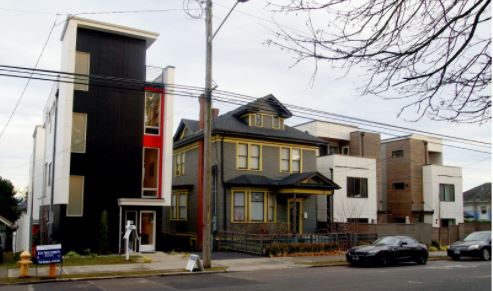Motivation

Research Questions
To explore the effect of the Seattle $15 minimum wage ordinance in context of this tech boom on Seattle low-wage workers, we used the unique Washington Merged Longitudinal Administrative Data (WMLAD) to ask the following questions:
- Who are low-wage workers and where do they live over time?
- How much do they spend on housing?
- Are they moving over time?
- What are the changes in their work commute patterns?
Background
In 2014, Seattle (occupied Coast Salish land) was the first major city to pass a $15 minimum wage. Policymakers hoped that higher wages for low-paid workers would reduce inequality and poverty and make Seattle workers and their families better off. However, Seattle’s $15 wage phase-in coincided with another economic jolt—the rapid influx of tens of thousands of high-paid technology workers.
Increased housing prices and development, particularly high-end housing, exacerbated by these new tech workers, have led to further gentrification. As a result, low-wage workers are being priced out of Seattle housing just as the raise to $15 took effect.
Prior research on minimum wage changes within the United States has been sparse. The dearth of research is partly due to the lack of minimum wage changes at the state and federal level, with the last federal minimum wage increase occurring in 2009 (US Department of Labor). However, most of the research focuses on how minimum wage changes affects the demand of laborers (Agarwal et al., 2020). From an economic standpoint, there are mixed findings on whether the minimum wage increases or decreases demand (learn more here).
Beyond supply/demand arguments, there are critical considerations about the effects of minimum wage policy extending to housing, commute times, and demographic distribution of low-wage workers, which may influence the real effects of a minimum wage policy. Low-wage workers are far more likely to be 30-50% rent-burdened compared to middle and high-income earners (read more here). Notably, city, state, and federal minimum wage policies are directly relevant to income inequality and the ability to afford housing. Scholarship investigating housing and income inequality finds that housing prices are rising faster than income across many American cities, leading to the displacement of low-wage workers (read more here). As such, what has previously been noted as a ‘housing crisis’ or ‘housing affordability crisis’ is, in earnest, an income inequality crisis (watch this video to learn more). Some politicians and advocates argue that investing in more affordable housing strategies such as restricting evictions, providing rental assistance, and offering housing subsidies, should be done with rising income to address these crises. Critically, policymakers must consider both housing and income inequality to understand the efficacy of minimum wage policies on worker lives.
Activists, community organizers, and Seattle community members have spent years documenting the effects of housing and income inequality for Indigenous, Black, immigrant communities, and other communities of color, more broadly making low wages. For example, Community Inclusion & Equity in the Changing Public Realm has explored how histories of colonialism, racism, and capitalism have materially affected people’s lived experiences. They have utilized qualitative and community-led narrative representations of gentrification happening across Seattle neighborhoods which further frames our interest in visualizing how the Seattle Minimum Wage Ordinance affected low-wage workers and how we can leverage large-scale quantitative data to understand worker well-being.
Stakeholders
The project team has worked to align project objectives and deliverables with stakeholder needs. To that end, the team has engaged a variety of stakeholders, including Washington State Department of Social and Health Services, concerned community members, Washington State Institutional Review Board, to understand the context of the data, the context of the topic, and to inform the final deliverables for the project.
We have identified the two use cases:
-
Geospatial visualizations for advocacy purposes
-
WMLAD documentation and workflow protocols to inform future WMLAD researchers
Ethics
Primary ethical considerations for this project:
- Each Data Point is a Person
This mindset has been a guide throughout our work. Having this mindset helps us deal with each data point with care. Furthermore, it influences our analytical and design choices. For example, we intentionally chose which level of detail to provide to ensure people’s residential and work addresses were not discernable. Lastly, we also make sure not to contribute to the perpetuation of erasure of certain communities, such as Indigenous, Black, and immigrant people. We are intentional with labeling our variables and values, such as languages and races/ethnicities.
- Centering Equity in our Work
We understand that data is not objective and is laden with value and power. Centering equity in data encapsulates the notion that we do not perpetuate stereotypes, marginalization, and bias. While we could not speak with the individuals in our dataset, we were intentional about communicating with stakeholders with insight into community concerns and desires related to issues of housing and income inequality.
- Misuse of the Data/Narrative
Political and nonpolitical actors passionately debate whether to raise the minimum wage. As a result, bad actors can use the findings from our project to push a narrative that does not align with our findings. While we can’t control how people use the information from this project, we do our due diligence to articulate the findings and implications of our work.